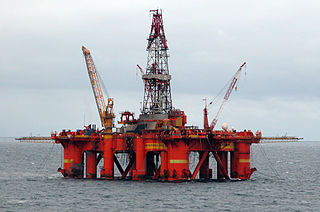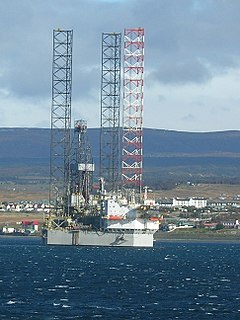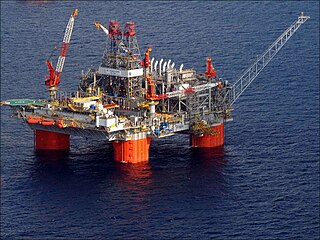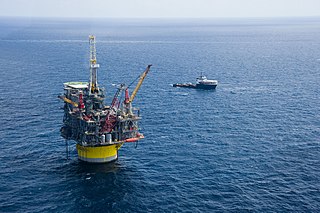
An oil platform, offshore platform, or offshore drilling rig is a large structure with facilities for well drilling to explore, extract, store, and process petroleum and natural gas that lies in rock formations beneath the seabed. Many oil platforms will also contain facilities to accommodate their workforce. Most commonly, oil platforms engage in activities on the continental shelf, though they can also be used in lakes, inshore waters, and inland seas. Depending on the circumstances, the platform may be fixed to the ocean floor, consist of an artificial island, or float. Remote subsea wells may also be connected to a platform by flow lines and by umbilical connections. These sub-sea solutions may consist of one or more subsea wells or of one or more manifold centres for multiple wells.

Offshore construction is the installation of structures and facilities in a marine environment, usually for the production and transmission of electricity, oil, gas and other resources. It is also called maritime engineering.
Petronius is a deepwater compliant tower oil platform built from 1997 to 2000 and operated by Chevron in the Gulf of Mexico, 210 km southeast of New Orleans, United States.

A semi-submersible platform is a specialised marine vessel used in offshore roles including as offshore drilling rigs, safety vessels, oil production platforms, and heavy lift cranes. They have good ship stability and seakeeping, better than drillships.

A floating production storage and offloading (FPSO) unit is a floating vessel used by the offshore oil and gas industry for the production and processing of hydrocarbons, and for the storage of oil. An FPSO vessel is designed to receive hydrocarbons produced by itself or from nearby platforms or subsea template, process them, and store oil until it can be offloaded onto a tanker or, less frequently, transported through a pipeline. FPSOs are preferred in frontier offshore regions as they are easy to install, and do not require a local pipeline infrastructure to export oil. FPSOs can be a conversion of an oil tanker or can be a vessel built specially for the application. A vessel used only to store oil is referred to as a floating storage and offloading (FSO) vessel.

A tension-leg platform (TLP) or extended tension leg platform (ETLP) is a vertically moored floating structure normally used for the offshore production of oil or gas, and is particularly suited for water depths greater than 300 metres and less than 1500 metres. Use of tension-leg platforms has also been proposed for offshore wind turbines.

Hibernia is an oil field in the North Atlantic Ocean, approximately 315 kilometres (196 mi) east-southeast of St. John's, Newfoundland, Canada, in 80 m of water.

The Saipem 7000 is the world's third largest semi-submersible crane vessel, after the SSCV Sleipnir and the SSCV Thialf. It is owned by the oil and gas industry contractor Saipem S.p.A.

The Clair oilfield is an offshore oil field in Scottish territorial waters 75 kilometres (47 mi) west of Shetland in water depths of up to 140 metres (460 ft). It extends over an area of some 220 square kilometres (85 sq mi), covering five licence blocks.

A jackup rig or a self-elevating unit is a type of mobile platform that consists of a buoyant hull fitted with a number of movable legs, capable of raising its hull over the surface of the sea. The buoyant hull enables transportation of the unit and all attached machinery to a desired location. Once on location the hull is raised to the required elevation above the sea surface supported by the sea bed. The legs of such units may be designed to penetrate the sea bed, may be fitted with enlarged sections or footings, or may be attached to a bottom mat. Generally jackup rigs are not self-propelled and rely on tugs or heavy lift ships for transportation.

Pioneering Spirit is a catamaran crane vessel owned by the Switzerland-based Allseas Group designed for the single-lift installation and removal of large oil and gas platforms and the installation of record-weight pipelines. The 382-metre-long (1,253 ft), 124-metre-wide (407 ft) vessel is the world's largest vessel by gross tonnage and was built in South Korea by Daewoo Shipbuilding & Marine Engineering at a cost of €2.6 billion. It commenced offshore operations in August 2016.
Offshore concrete structures have been in use successfully for about 50 years. They serve the same purpose as their steel counterparts in the oil and gas production and storage. The first concrete oil platform has been installed in the North Sea in the Ekofisk field in 1973 by Phillips Petroleum. Since then 47 major concrete offshore structures have been built.

The Hutton oil field, located on the UK continental shelf, was the location for the first ever production Tension Leg Platform (TLP).

The Magnus oilfield is a large oilfield in the United Kingdom's zone of North Sea. It is located 160 kilometres (99 mi) north-east of the Shetland Islands. The field is located mainly in Block 211/12a. Resources are estimated to total 1.54 billion barrels of oil, of which 869 million barrels are recoverable reserves.

Oseberg South is an offshore oil field in the North Sea, located 115 kilometres (71 mi) from the coastline and 13 kilometres (8.1 mi) south of Oseberg Oil Field. Oseberg Sør was discovered in 1984. The field was developed with a fixed production, drilling and quarters (PDQ) facility and is operated by Statoil. The first stage phase processing is done at the Oseberg Øst platform. The second and third phase processing of oil is done at the Oseberg Field Center and it is then transported to Sture terminal in Norway through the Oseberg Transport System. The development of the Oseberg Sør was approved in 1977. Recent updates include approval of J structure which started producing in November 2006 and Oseberg Sør G Sentral which has been developed in 2009.

Thunder Horse PDQ is a BP plc and ExxonMobil joint venture semi-submersible oil platform on location over the Mississippi Canyon Thunder Horse oil field, in deepwater Gulf of Mexico, 150 miles (240 km) southeast of New Orleans, moored in waters of 1,840 metres (6,040 ft). The "PDQ" identifies the platform as being a Production and oil Drilling facility with crew Quarters.

Perdido (spanish for lost) is the deepest floating oil platform in the world at a water depth of about 2450 meters (8040 feet) operated by the Shell Oil Company in the Gulf of Mexico. At 267 meters, the above water portion of the structure is almost as tall as the Eiffel Tower. The platform is located in the Perdido fold belt which is a rich discovery of crude oil and natural gas. The Perdido spar began production in 2010 and its peak production is 100,000 barrels of oil equivalent (ca. 16,000 m3/d) and 200 million cubic feet of gas per day (ca. 5.7*106 m3/d).
The Aasta Hansteen spar is a floating production storage and offloading (FPSO) unit for natural gas operated by Equinor located 186 miles offshore in the Norwegian Sea. It is the first spar platform to be located on the Norwegian Continental Shelf (NCS). The Aasta Hansteen is named after Norwegian painter, writer and early feminist
Gannet is an oil and gas field located in the United Kingdom's continental shelf in the North Sea. It is 180 km (110 mi) east of Aberdeen, and the water depth at the Gannet offshore installation is 95 m (312 ft). The field is located in Blocks 22/21, 22/25, 22/26 and 21/30. It is half-owned by Royal Dutch Shell (50%) and partly by ExxonMobil (50%) and has been operated by Shell UK Ltd since ‘first oil’ in November 1993. The Gannet A installation is the host platform for subsea tiebacks designated Gannet B to G. Like most Shell fields in the central and northern North Sea the field is named after a sea bird the gannet.
The Schredeneck-See oil field was a significant oil field in the German sector of the Baltic Sea. It was the first oil field in the Baltic, and was Germany’s first offshore oil field. lt produced oil from 1984 until 2000.











